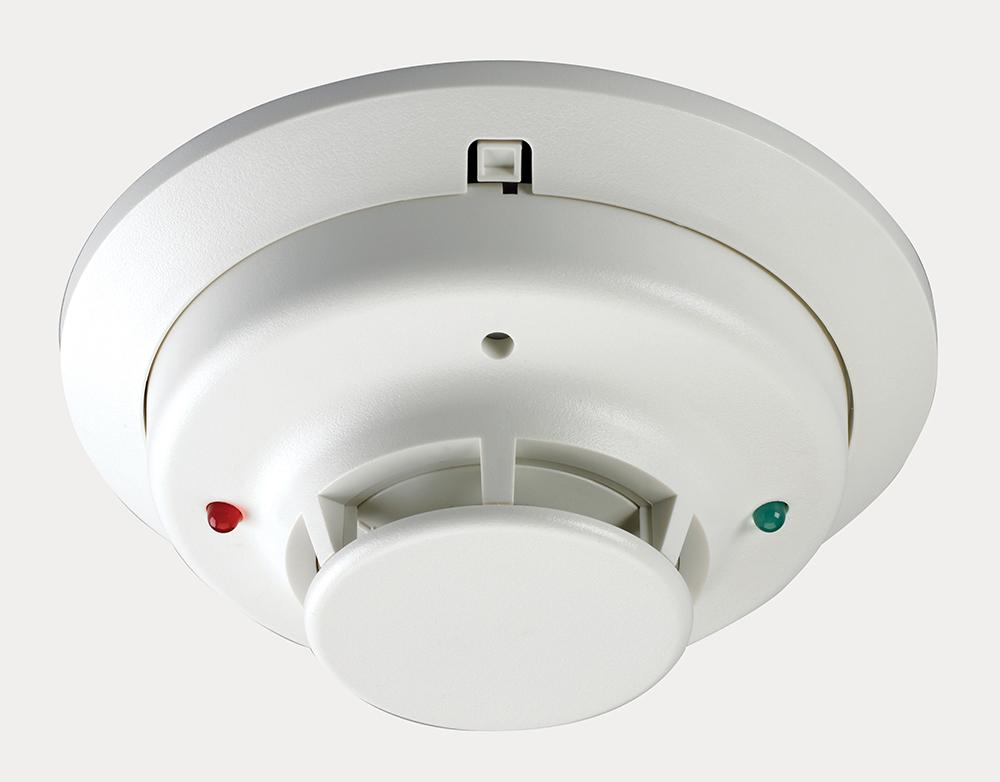
Smoke Detector
• Customers need service and supplies to continue without disruption.
• Suppliers demand agreements and payments to be without breach.
• Employees expect to be safe in the facility, and for employment to continue.
• Shareholders expect management to remain in control through any crisis.
• Regulatory agencies / Insurers demand that standards are met without exception.
Smoke Detectors will generally detect a fire far sooner than heat detectors. It is therefore preferable to fit Smoke Detectors unless there is any possibility of false or unwanted alarms. It is not advisable for example to fit a Smoke Detector in a kitchen as anybody burning toast would cause an unwanted alarm.
Heat Detectors should be fitted in boiler rooms, generator rooms, garages and dusty areas. The products of combustion produced by a boiler, a leaky exhaust on a generator or exhaust fumes from a vehicle could all cause a smoke detector to operate and produce an unwanted alarm.
Fixed Temperature Heat Detectors should be installed in areas where one would normally expect a sudden rise in temperature for instance kitchens and boiler rooms.
Rate of Rise Heat Detectors should be installed where Smoke Detectors would be unsuitable but one would not expect a sudden rise in temperature for instance, garages, car parks, dusty workshops etc.
There are two basic types of Point Smoke Detectors:
1 .Ionization chamber Smoke Detectors which are very sensitive to smoke with small particles i.e: fresh cellulosic smoke and the source of almost invisible smoke one gets with burning paper and spirit. They are relatively insensitive to smoke with large particles for example, smoke produced by burning plastics or stale smoke.
2. Optical Smoke Detectors are sensitive to optically dense smoke ie: smoke with large particles and they are relatively insensitive to optically thin smoke.
Why use Smoke Detection?
Smoke detection provides early warning & time to avoid loss.
The alternatives.
Passive fire protection.
• Only reduces the risk of total loss.
• Does little to reduce business interruption.
• Helps to prevent propagation.
Suppression.
• Requires detection!
• Creates risks of business interruption and loss.
Sprinklers.
• Designed to protect the building and not the contents (contain rather than extinguish fire).
• Stock damage.
Insurance.
• Does little to reduce business interruption or threats to life safety.
• Effective to reduce some financial exposure.
Early Detection Enables:
Time…to investigate and understand the threat
Time…to prepare staff and visitors
Time…to stage the response and avoid the cost of nuisance alarms
Time…to investigate options for control of the fire
Time…to transfer data and processes to
redundant systems
Time…to evacuate
Time…to suppress the fire
Time…to ensure business continuity.
Aspirating smoke detector (ASD)
– What is it?
An aspirating smoke detector (ASD) is a system used in active fire protection, consisting of a central detection unit which draws air through a network of pipes to detect smoke. The sampling chamber is based on a nephelometer that detects the presence of smoke particles suspended in air by detecting the light scattered by them in the chamber. ASDs can typically detect smoke before it is visible to the naked eye.
It is a “smoke detector, in which air and aerosols are drawn through a sampling device and carried to one or more smoke sensing elements by an integral aspirator” (EN54-20 definition)
In most cases aspirating smoke detectors require a fan unit to draw in a sample of air from the protected area through its network of pipes.
Conventional Point-Type Detectors:
• Low sensitivity.
• Passive – Wait for smoke to enter their chamber + inherent attenuation.
• No way to know if they are working because there’s no alert of blockage.
• Higher probability of nuisance alarms.
• Don’t maintain performance.
• Hard to maintain on ceilings, under floors.
Very Early Warning Smoke Detectors(ASD’s)
• Highly sensitive (if you want) and more reliable at high sensitivity.
• Tolerant of air dilution and high airflow.
• Actively draw air samples to a central detector.
• Monitor airflow to ensure reliable sampling.
• Maintain integrity of the optics for absolute smoke detection.
• Allow centralized maintenance.
There is no downtime. Every second lost, every transaction missed, every bit of data destroyed can mean huge financial losses. So to keep your mission critical facility running 24/7, you need to be alerted to the faintest traces of smoke — the first indication of system trouble. Hence the Aspirating smoke detectors.
Application areas.
Aspirating smoke detection is particularly suitable for:
• Clean areas such as data centers and clean rooms.
• Hard-to-access areas like cable ducts or power stations.
• Historical buildings like theaters, museums and libraries.
• Restrictive areas such as operating rooms.
• Public places such as metro stations, parking garages or prisons.
• Harsh environments like industrial production areas.
• High-ceiling and ventilated areas like warehouses.
Benefits at a glance.
• Very early fire detection for fastest possible warning and response.
• High detection reliability prevents false alarms.
• Suitable for difficult environments.

This is good info Eng. Makaa